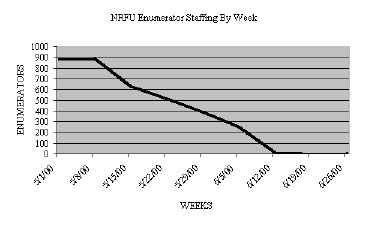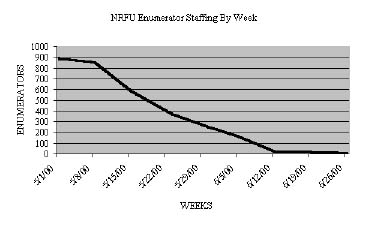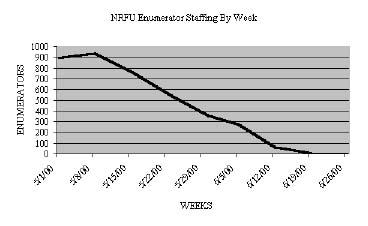| Report to Congress: October 1, 2000 |
Los Angeles Region
John E. Reeder Jr. served as Director of the Los Angeles Regional Census Center during the
2000 Census operations, but has since retired.
Following are the states located in the Los Angeles Region and the Local Census Offices in
those states reviewed by the Census Monitoring Board:
California (Southern): Compton LCO; Los Angeles West Central LCO; San Diego South LCO
Hawaii
Highlights of the Region include:
- Approximately 8,836,874 Housing Units
- 76,200 Square Miles
- 2 States, 24 Counties
- 44 American Indian Reservations
- 362 Governmental Units
- 37 Members of the U.S. House of Representatives
- 4 U.S. Senators
- 41 Local Census Offices
Additional items of interest include:
- Third in population concentration behind New York and Philadelphia
- Five counties are among the top 10 gaining population within the U.S.
- Region has four of the top counties receiving direct Federal expenditures (Los Angeles, San Diego, Orange and Honolulu)
- The greater Los Angeles metropolitan area has a Gross Product that would rank it 11th among the world's nations
- Three of the region's counties are among the top 10 in business employment and establishments (Los Angeles, San Diego and Orange)
COMPTON
Local Census Office #3215
Overview
Dates of Visits:
April 13, 2000
May 24, 2000
June 27, 2000
Mailback Response Rate
64%
NRFU Workload
48,945 housing units
LCO Type
Type A Office (entirely mailout/mailback, mainly urban, hardest to enumerate)
Geographic Description
The Compton LCO was located in Room 1550 of the Gateway Plaza Shopping Center at 1610
West Rosecrans Avenue in Compton, California. According to the February 2000 Tract Action
Plan, there were 72 tracts in the LCO, of which 30 (41.67 percent) were HTE. According to the
1990 PDB, there were 127,404 housing units. The LCO included five cities — Compton,
Gardena, Lawndale, Hawthorne and Los Angeles. All 18 tracts in Compton were HTE. The LCO's
largest populations are African-Americans, Hispanics and Asian-Americans; major languages are
English and Spanish.
Pay Rates


COMPTON
Local Census Office #3215
Presidential Members' Summary
Summary
The Compton LCO quickly surpassed its recruiting and hiring goals and NRFU proceeded smoothly.
Management fostered a friendly, orderly atmosphere that encouraged workers to be more
productive. These feats were especially impressive given the high percentage of HTE tracts in the
LCO's district—60 out of 72 tracts.
Observations
The Compton LCO exceeded virtually every goal measured by the Bureau. Mail response was
64 percent, an astounding 15 percent higher than the Bureau expected. This high mail response
contributed to the office's ability to finish NRFU operations ahead of the national deadline.
The office met recruiting, hiring, retention and enumeration goals in exemplary fashion. Most
notably, it finished with the highest number of recruits relative to its goal in the region—204 percent.
Selectors hired enumerators to work in their own neighborhoods. Managers cited low
employee turnover and a high unemployment rate as major reasons for success in the field. A contingent
of elderly women bolstered the strong, consistent staff.
The LCO was particularly well organized. Upon each visit, Board staff received a thorough
presentation from all managers. Managers were obviously proud of their work. During our visits,
top managers reported working 60 hour weeks on average (usually without over-time pay) during NRFU.
The AMA reported working 14-16 hour days routinely.
Local government and community leaders held weekly strategy meetings to improve mail
response rates and encourage cooperation with enumerators during NRFU. The State of California
allocated $24.7 million to assist localities with their census effort. As the nation's most undercounted state
in 1990, California improved its mail response rate by 5 percentage points, beating the national
average with 70 percent.
COMPTON
Local Census Office #3215
Congressional Members' Summary
Summary
The Compton office showed how strong community-based organizations and dedicated efforts
by the LCO staff can reverse negative stereotypes and prevent failure. During a June 26 hearing
held in Los Angeles, the CMBC noted that such outreach was crucial in getting necessary information
to the public.
Observations
During all three visits, the Monitoring Board staff received professional-quality presentations
that were consistent with the office's efforts throughout Census 2000 operations. The LCO staff
cultivated relations with various community-based organizations, such as the NAACP, Urban
League, MALDEF and various Asian-American groups, as well as programs such as Welfare-to-Work
and GAIN (Greater Avenue to Independence) that encouraged people to be counted.
To put this census in perspective, the city's 1990 results were considered the worst in the State
of California. The undercount in the city of Compton was attributed to gang activities, apathy,
housing issues, welfare problems and population diversity. It appears that efforts were undertaken
so that a similar undercount will not occur in 2000.
Residents of the Compton LCO improved the MO/MB Initial Response Rate dramatically.
The 2000 Census mail return rate was 63.67 percent, compared to the 1990 rate of 47.50 percent,
an increase of over 16 percentage points.
The good working relationships with local CCCs and community organizations were critical to
the office's ability to maintain staffing levels. Although the office had high turnover and dropout
rates and almost 900 applicants who failed the background check, the office had far more applicants
and trained employees than were required for NRFU.
Because the LCO had gained the greater community's confidence early, the office was able
to implement its HTE plan in certain areas requiring different enumeration strategies. For
instance, small teams of four to five enumerators or 10-15 enumerators were deployed to various
apartment complexes with positive results. The office's 52 QACs and 86 "Be Counted!" sites made
contact with 4,300 people, an impressive amount of the population.
Through teamwork and aggressive efforts, the LCO made significant strides to ensure a full
enumeration.
LOS ANGELES WEST CENTRAL
Local Census Office #3227
Overview
Dates of Visits:
April 17, 2000
May 25, 2000
June 28, 2000
Mailback Response Rate
56%
NRFU Workload
60,442 housing units
LCO Type
Type A Office (entirely mailout/mailback, mainly urban, hardest to enumerate)
Geographic Description
The Los Angeles West Central LCO was at 8510 Higuera Street in Culver City, California.
According to the February 2000 Tract Action Plan, there were 62 tracts in the LCO, of which 46
(74.19 percent) were HTE. According to the 1990 PDB, there were 125,789 housing units. The
LCO's largest populations were Hispanics (51 percent), Asian Americans, African-Americans and whites.
The office was located three miles outside the LCO's boundaries. The General Services
Administration was unable to secure a lease in the Los Angeles West Central region. This LCO was also
known as the Culver City East LCO. The Culver City LCO (3249) was at the same complex.
Pay Rates


LOS ANGELES WEST CENTRAL
Local Census Office #3227
Presidential Members' Summary
Summary
This office faced language, poverty, population density, and crime challenges, but overcame
these obstacles with hard work and good planning.
Observations
The LCO district is very large and racially and ethnically diverse. Of the estimated 940,517
residents in the LCO district, approximately 51 percent are Hispanic, 13 percent African American,
10 percent white, 19 percent Pacific Islander, 6 percent Asian, and 1 percent American Indian.
Generally, Koreans live to the north, blacks to the south, and whites to the northwest. Hispanics are
more widely distributed.
The LCO's office space was located in Culver City, a couple miles west of the office's jurisdiction.
Apparently, GSA could not find appropriate office space on a short-term lease within the LCO area.
Managers, who were also frustrated by a dearth in parking around the LCO, speculated that a
better location should have been found.
In 44 of the 77 tracts, LCO managers reported little trouble hiring and retaining the required
number of enumerators. Managers said that word spread quickly throughout the Latino
community (which reportedly has a higher than average unemployment rate) that the Census Bureau
offered good pay and flexible hours. The LCO did, however, have some trouble hiring whites and
bilinguals in various languages, including Spanish. To deal with this deficiency, the office "borrowed"
several bilingual enumerators from neighboring LCOs.
LCO managers reported that older women were among the most convincing enumerators. In
addition, a team of multicultural enumerators known as the "dream team" was very effective in
certain HTE areas.
The Board met with community leaders of Los Angeles at a hearing in Los Angeles on June
26, 2000. At this meeting, the Board was impressed with the area's CCC activities such as the
two thousand blankets donated which helped enumerators count the homeless. As an inducement,
enumerators gave a blanket to each person who filled out a form.
In addition, the State of California allocated $24.7 million to assist localities with their
census effort. As the nation's most undercounted state in 1990, California improved its mail response
rate by 5 percentage points, beating the national average with 70 percent.
LOS ANGELES WEST CENTRAL
Local Census Office #3227
Congressional Members' Summary
Summary
The Los Angeles West Central office faced several challenges, including a high number of
HTE tracts and a linguistically isolated Hispanic community. The LCO chose to work with local
partners to meet recruiting goals, establish QACs, and work effectively with hard-to-count
neighborhoods.
Observations
In spite of several hurdles, the office was still ranked near the top by recruiting among the
Los Angeles RCC's 41 offices and thus had far more applicants and trained employees than were
required for NRFU. Although the local CCC was not formed until December 1999, it was
effective in referring facilitators and enumerators for employment. Its most significant public event was
held at the Baldwin Hills Mall, where 2,000 attended. The good working relationships with the
CCC and community organizations were critical to the office's ability to maintain staffing levels.
Because heavy gang activity and high crime rates challenged the community, almost 2,900
applicants failed the background check.
The LCO management consistently noted many Hispanics (the dominant ethnic group in this
LCO) could not communicate effectively in English and thus could not pass the English Proficiency Test.
Because they could not hire Spanish-speaking enumerators, the LCO was forced to share
bilingual enumerators with a neighboring office.
During the May 25 visit, Monitoring Board staff received troubling reports that highlighted
the importance of a facilitating CCC. Specifically, we learned that enumerators had been shot
at, threatened, and received threatening messages on cellular phones and pagers. These incidents
affected the LCOM's ability to communicate with enumerators in a timely manner.
Bureau staff cultivated relations with various community-based organizations like the
NAACP, Urban League, Brotherhood Crusade, MALDEF and Korean Federation. These organizations
helped established almost 70 QACs, which were instrumental in answering respondents' questions.
The inability to locate an office within the boundaries of the LCO posed significant problems
for many census stakeholders. During days when film production was scheduled, private security
and local police blocked off a four-block radius. The building had poor signage, was very hard to
find and had only three parking spaces for its employees. The office had a high no-show rate for
job applicants scheduled for enumerator tests and oversight agencies had difficulty visiting the office.
SAN DIEGO SOUTH
Local Census Office #3236
Overview
Dates of Visits:
March 31, 2000
May 4, 2000
June 13, 2000
Mailback Response Rate
65%
NRFU Workload
48,602 housing units
LCO Type
Type A Office (entirely mailout/mailback, mainly urban, hardest to enumerate)
Geographic Description
The San Diego South LCO was located at 649 Anita Street in Chula Vista, California.
According to the February 2000 Tract Action Plan, there were 72 tracts in the LCO, of which 3 (4.17
percent) were HTE, due primarily to heavy gang activity reported in Imperial Beach and San Ysidro.
According to the 1990 PDB, there were 118,478 housing units. The LCO's largest populations
were Hispanics, Filipino Americans (concentrated in National City) and Japanese Americans (in
Chula Vista). There were also various ethnic groups in the University area.
Pay Rates


SAN DIEGO SOUTH
Local Census Office #3236
Presidential Members' Summary
Summary
San Diego South registered a 66 percent mail response rate, 18 percent greater than
anticipated. This initial success was attributed to both the Census Bureau's and the State of California's
census advertising campaign, along with excellent outreach from the LCO and the local community.
Observations
The higher than expected mail response reduced the NRFU workload thus enabling the office
to focus its attention on enumeration and enumerator safety in blighted areas. Most
impressively, management recruited representatives from local gangs to help enumerators safely navigate
particularly troubled neighborhoods. Furthermore, police detectives helped enumerators avoid
conflict by teaching them how to interpret graffiti, tattoos, and body language.
Covering an ethnically and geographically diverse jurisdiction, the LCOM reported that its
ability to complete its NRFU workload of just over 48,000 households was greatly enhanced by
promotional media campaigns sponsored by the Bureau and the State of California. Over 10
different languages were used during NRFU operations spanning the southern part of the city of San
Diego to the desert along the Mexican border.
Facilitators accompanied enumerators to gain access to communities traditionally leery of the
census. Facilitators were also effectively used in the Boston South, Denver, El Paso and
Portland LCOs. Both the Board and the LCOM agree that the cultural facilitator program was effective.
Enumerators could benefit from photo-identification badges in this urban LCO. Badges used
during this census identified enumerators by signature only. Residents might be more
comfortable with a picture of each enumerator on his or her badge. Managers in this, the Orleans Parish
and New York North LCOs mentioned this suggestion.
Upon our third visit, the LCOM confirmed news stories in mid-May that the LCO had
unknowingly hired an employee with an unacceptable criminal record. The employee had a history of
using borrowed social security numbers. The LCOM reported the employee's work performance
was excellent and investigators searching his home found no evidence of malfeasance. However,
he resigned immediately after the stories became public and a local criminal investigation ensued,
thus resolving the issue.
The LCO received excellent cooperation from local officials and community activists. During
the Board's Hearing in San Diego on June 22, we heard how two dozen programs, supported by
nearly $400,000 in state grants, were launched to target minority populations, the homeless, low-income
people and the elderly about the importance of returning census forms. San Diego's City
Council sponsored a census theater troupe that performed in both Spanish and English. The Mayor and
City Council of Chula Vista were particularly active in promoting the census.
Furthermore, the State of California allocated $24.7 million to assist localities with their
census effort. As the nation's most undercounted state in 1990, California improved its mail response
rate by 5 percentage points, beating the national average with 70 percent.
An enumerator told Board staff that she would have preferred to wear a photo-identification
badge, especially in urban areas where residents are most concerned about security. Badges used
during this census identified enumerators by signature only. Residents might be more comfortable
with each enumerator's photograph on his or her badge.
SAN DIEGO SOUTH
Local Census Office #3236
Congressional Members' Summary
Summary
The San Diego South LCO had a successful mail back response rate. Response rates for four
cities in this LCO's area were over 70 percent and two others were above the national average of
65 percent. However, we are concerned with the high number of UAAs, as well as procedures used
in Close Out.
Observations
Perhaps the office's most significant event was coverage by national media of an enumerator
who was found to be a convicted felon. As reported by the
Associated Press on May 17, the parolee, who had been convicted of stealing Social Security numbers and credit cards, had worked as
a payroll processor. The employee provided a false name and social security number as part of
the job application. Although the person was a model employee and promoted to crew leader, he
was eventually discovered and terminated. His census materials were returned and the work redone
in order to preserve the data's integrity.
To the LCO's credit, employee turnover was very low. With unemployment less than two
percent in San Diego County, the office's ethnically diverse staff of almost 1,100 enumerators
included Navy and Marine retirees and the young and old.
The LCOM, a non-citizen himself, was in a unique position to address one of the office's largest challenges—counting undocumented immigrants.
The LCO was challenged by a high number of UAAs, as reported during the March 31 visit.
The original mailout universe was approximately 143,000 and almost 15 percent (or over 21,000
forms) were returned to the LCO as UAA.
We are concerned with the close-out procedures reported during the June 13 visit. Reportedly,
the office's procedure (used to complete the final five percent of its NRFU workload) was simply
to make contact and perform a general observation to gather gender, age and ethnic background.
The LCO staff did not elaborate on their decision to make less than the six required contacts or make
a more aggressive attempt to gain additional information. The LCO's progress during NRFU was
so rapid that about 300 enumerators were temporarily assigned to the San Diego Downtown
(3235) LCO in order to help complete that office's operations.
To prevent gang-related violence, enumerators worked with the local CCC and law
enforcement and other community partners to develop prudent strategies for enumeration in certain areas.
The San Diego South LCO experienced delays in timely approval of services like parking lot
security lights and weekend janitorial services. It seemed that recruiting efforts would have been
easier had these accommodations been in place from the beginning. In future censuses, these
services could be helpful in trying to compete for temporary employees in a tight job market.





